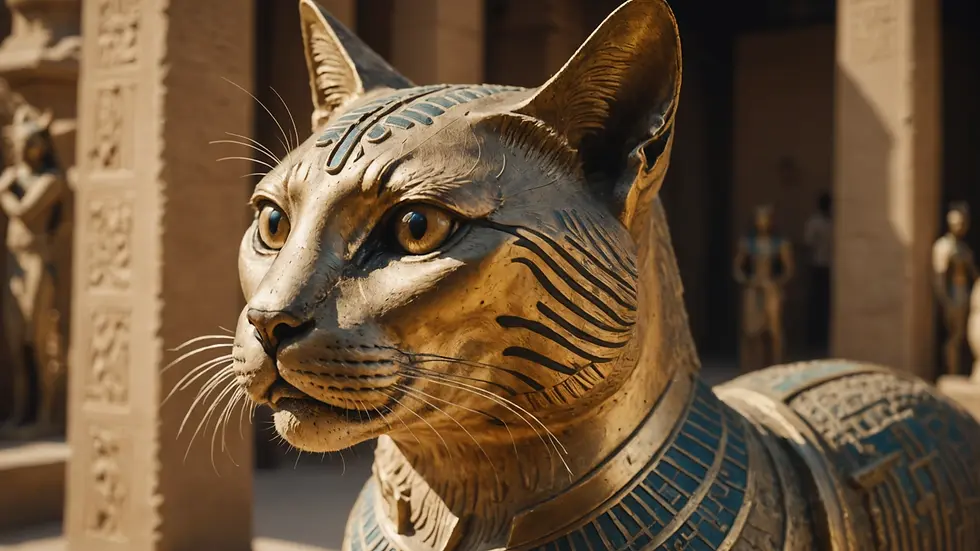Uncovering the Feline Mysteries: Cats in the Ancient Civilizations
- Jyotiraj Borah
- Feb 5
- 4 min read
Cats have fascinated humans for thousands of years. These intriguing creatures went beyond mere companionship in ancient times. They were revered as sacred animals, effective pest controllers, and sources of inspiration in art and literature. Understanding the various ways different cultures embraced cats offers a fascinating insight into human-animal relationships throughout history.
Let’s explore how ancient societies regarded these feline companions—from worship to practical utility—and their lasting impact on culture.
Cats in Ancient Egypt
Ancient Egypt is well-known for its deep respect for cats. These graceful animals served as symbols of independence and were integral to Egyptian beliefs and practices.
Cats were seen as sacred beings associated with the goddess Bastet, who represented protection and motherhood. Bastet was often depicted as a lioness or domestic cat, reflecting both the fierce and gentle sides of felines. Statues and drawings from this time often showcased cats in domestic settings, indicating their valued presence in households.

Beyond their spiritual significance, cats played a crucial role in agriculture. Their hunting skills made them effective at controlling pests that threatened vital grain supplies. Egyptian households regarded them as valuable partners, and laws were in place to protect cats. For instance, an accidental cat death could lead to severe penalties, sometimes even execution.
The reverence extended beyond life; upon death, cats were mummified, reflecting the strong bond between Egyptians and their feline friends. Families ensured a proper burial, signifying their devotion and underscoring the role of cats in daily life. With this background, it is no wonder cats continue to influence modern culture today.
Cats in Greece and Rome
In ancient Greece and Rome, cats were appreciated but not revered to the same level as in Egypt. Here, they were valued primarily for their pest control abilities and charming personalities.
In Greece, cats were recognized for their hunting skills and often kept in homes for this purpose. Literary works from this time, including mentions by thinkers like Aristotle, acknowledge the comfort and elegance that cats brought to households. However, they often played second fiddle to dogs, which were more highly regarded as companions.
Conversely, the Romans admired cats similarly to the Egyptians. They allowed cats to roam freely in homes, using them as natural pest controllers. Roman mosaics and artifacts often depict cats, showcasing their affectionate roles despite not reaching divine status.
Cats were also subjects of superstition; their behavior could be interpreted as omens. For example, many believed that the death of a cat brought bad luck, enhancing the mystique surrounding these animals.

Cats in Asia: The East's Cultural Relationship with Cats
The significance of cats in Asia varies widely among different cultures, highlighting diverse interpretations and beliefs.
In China, cats have been cherished for their beauty and pest control abilities for centuries. Records indicate that cats were domesticated as early as 5,000 years ago. The idiom "the cat is a treasured friend" illustrates the warm bonds formed between cats and families. Interestingly, in Chinese culture, black cats symbolize prosperity and good fortune, quite different from many Western beliefs.
Japan also holds cats in high esteem, celebrating them in various cultural traditions. The "maneki-neko," or beckoning cat, is a common talisman believed to attract good luck and financial success. Additionally, Shinto beliefs treat cats as protective figures, further embedding them in the cultural fabric. Ancient poetry frequently features cats, highlighting the admiration the Japanese have had for them throughout history.
Through expanding trade routes, cats adapted to new environments, proving that their connections to humanity spanned cultures and geography.
Cats in the Americas
In ancient American civilizations like the Aztecs and Incas, documented relationships with cats were less pronounced. However, evidence suggests that some tribes kept domesticated cats for their hunting abilities.
As European settlers arrived, the dynamics changed. Cats became essential in controlling the rats that followed ships to America. Their practical utility transitioned cats into trusted companions. Stories emerged, like those of ship cats protecting vital food supplies, reinforcing their value among sailors.
Stories of cats guarding ships and sailors from misfortunes began to circulate, contributing to their gradual rise in status as cherished household pets throughout the Americas. Through these connections, cats began to nestle into the hearts of many families.
The Artistic and Literary Representation of Cats
Throughout history, cats have inspired artists and writers alike, becoming central figures in creative expression. From ancient sculptures to modern literature, these felines have made their mark.
The ancient Egyptians led in showcasing cats through art forms like pottery and paintings. Iconic images featured cats in sacred contexts, emphasized in sculptures dedicated to Bastet. Wall paintings often depicted affectionate scenes, showcasing the emotional ties between cats and humans.
In Greek and Roman literature, we see numerous subtle references to cats. The poet Ovid highlighted the grace of cats in his work, portraying their influence on creative expression. As the centuries rolled on, the view of cats shifted; during the Middle Ages, they were sometimes linked to witchcraft, casting them in a more mysterious light.
Yet, the fascination with cats persisted. Today, they continue to inspire a range of artistic expressions, from literature to social media memes. Their legacies remind us of the enduring relationship we share with these captivating creatures.
Final Thoughts on Cats in Ancient Civilizations
The relationship between humans and cats in ancient civilizations reveals a complex blend of utility, admiration, and companionship. These creatures played key roles in cultural beliefs and everyday life. As sacred protectors in Egypt or practical hunters in Rome, cats left a significant mark on ancient societies.
In our modern world, it is vital to recognize the enduring legacy that cats have etched into our lives. Their history with humans illustrates how interconnected our lives have been, shaping our cultures, beliefs, and emotional attachments through time. As we continue to celebrate our feline friends, we honor the timeless bond that has persisted for centuries.




Comments